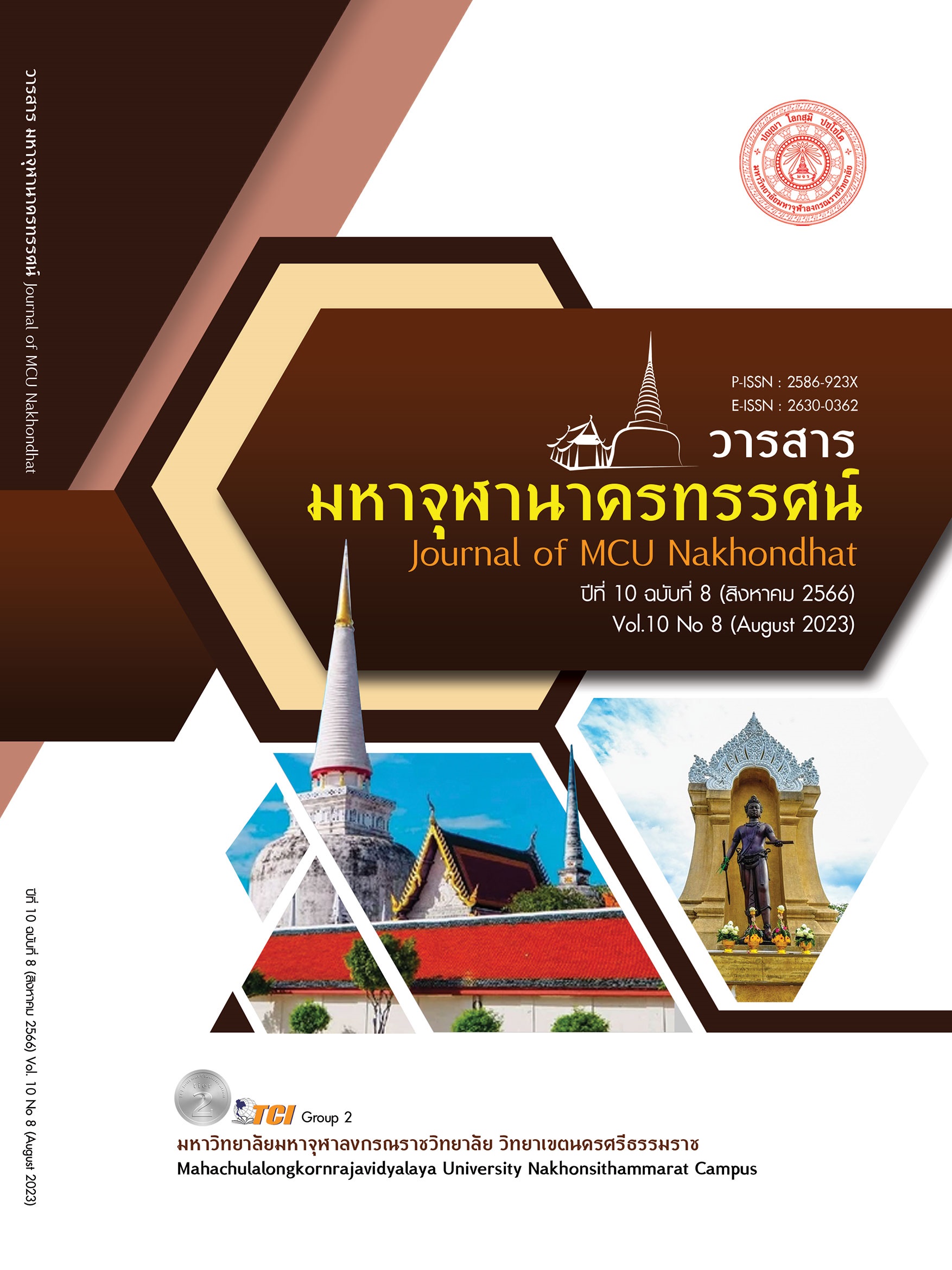THE STUDY OF KING RAMA VI’S SPEECHES AS DIDACTIC LITERATURE
Main Article Content
Abstract
The purpose of this research article is to conduct an analysis of the unique teachings and writing strategies found in the royal speeches of King Rama VI by using qualitative research. The study focuses on studying a total of 155 royal speeches delivered by King Rama VI between the years 1910 and 1925. The stages of the study are sequenced as reading, analyzing, organizing, and summarizing. The results of the analysis revealed that the royal speeches of King Rama VI, which are mostly in form of didactic, were directed towards a wide range of audience groups. These included members of the royal family, representatives from foreign governments, civil servants, monks, soldiers, forest scouts, citizens, teachers, and students. Moreover, it was found that the royal speeches were mostly directed to scouts and Boy Scouts reflecting social context during World War 1. Additionally, the royal speeches were delivered on various occasions, such as royal ceremonies, opening ceremonies, and ceremonies on special occasions and important days. On these occasions, King Rama VI mentioned the significance of the event, place, or work being celebrated. This indicates that he sought to acknowledge and appreciate the importance of these occasions and the individuals involved in them. The content of the royal speeches of King Rama VI mentioned the roles and responsibilities of the individuals present in the audience. This suggests that King Rama VI aimed to emphasize the importance of fulfilling one's duties and responsibilities within their respective roles in society. Good citizens are rooted from sense of community and concentrating on public interest. To foster good citizenship, it is essential to focus on methods of improving various aspects of life, including health, education, ethics, and the use of the rule of law in government. The composing techniques employed in the royal speeches of King Rama VI effectively presented the concept of good citizenship through literary writing techniques and a mix of rhetoric. The use of a rhetoric mix, including recounting experiences and the harmonious use of critical language, contributes to making the royal speeches interesting and helps the audience better understand the purpose of the communication.
Article Details

This work is licensed under a Creative Commons Attribution-NonCommercial-NoDerivatives 4.0 International License.
References
จิระพันธ์ ชาติชินเชาวน์. (2537). การดำเนินนโยบายชาตินิยมในรัชสมัยพระบาทสมเด็จพระมงกุฎเกล้าเจ้าอยู่หัว. ใน วิทยานิพนธ์ศึกษาศาสตร์มหาบัณฑิต สาขาพุทธศาสตร์มหาบัณฑิต. มหาวิทยาลัยศรีนครินทรวิโรฒ.
ชนัญชิดา บุญเหาะ. (2560). ความรักชาติในนิราศที่แต่งระหว่างรัชสมัยพระบาทสมเด็จพระมงกุฎเกล้าเจ้าอยู่หัวถึงรัชสมัยพระบาทสมเด็จพระเจ้าอยู่หัวอานันทมหิดล. ใน วิทยานิพนธ์อักษรศาสตรมหาบัณฑิต สาขาวิชาภาษาไทย. จุฬาลงกรณ์มหาวิทยาลัย.
ชิตาภา สุขพลำ. (2557). วาทนิพนธ์การเขียนเพื่อพูดในโอกาสต่าง ๆ. กรุงเทพมหานคร: สำนักพิมพ์จุฬาลงกรณ์มหาวิทยาลัย.
มงกุฎเกล้าเจ้าอยู่หัว, พระบาทสมเด็จพระ. (2493). ปลุกใจเสือป่า. พระนคร: โรงพิมพ์อำนวยศิลป์.
มงกุฎเกล้าเจ้าอยู่หัว, พระบาทสมเด็จพระ. (2500). พระบรมราโชวาทในงานวิสาขบูชาและแสดงคุณานุคุณพระบรมราชานุศาสนีของพระบาทสมเด็จพระรามาธิบดีศรีสินทรมหาวชิราวุธพระมงกุฎเกล้าเจ้าอยู่หัว. พระนคร: โรงพิมพ์มหามกุฏราชวิทยาลัย.
มงกุฎเกล้าเจ้าอยู่หัว, พระบาทสมเด็จพระ. (2529). พระราชดำรัสของพระบาทสมเด็จพระมงกุฎเกล้าเจ้าอยู่หัว รวม 100 ครั้ง. กรุงเทพมหานคร: คณะกรรมการมูลนิธิพระบรมราชานุสรณ์พระบาทสมเด็จพระมงกุฎเกล้าเจ้าอยู่หัว.
ยุภาพร เจือจินดา. (2528). เสือป่า : โครงสร้างขององค์กรและบทบาททางการเมือง. ใน วิทยานิพนธ์อักษรศาสตรมหาบัณฑิต สาขาวิชาประวัติศาสตร์. จุฬาลงกรณ์มหาวิทยาลัย.
ราชบัณฑิตยสถาน. (2545). พจนานุกรมศัพท์วรรณกรรม อังกฤษ - ไทย. กรุงเทพมหานคร: ราชบัณฑิตยสถาน.
ราชบัณฑิตยสถาน. (2556). พจนานุกรม ฉบับราชบัณฑิตยสถาน พ.ศ. 2554. กรุงเทพมหานคร: ราชบัณฑิตยสถาน.
สุวัฒนา เลี่ยมประวัติ. (2555). กลวิธีทางภาษาและแนวพระราชดำริจากพระราชดำรัสพระบาทสมเด็จพระมงกุฎเกล้าเจ้าอยู่หัว. ใน วชิราวุธราชปราชญ์ คณะอักษรศาสตร์. มหาวิทยาลัยศิลปากร.


